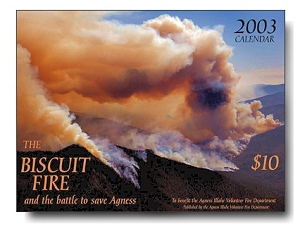
|
|
| www.wildfirenews.com | Updated 10. February 2003 |
LIABILITY INSURANCE FOR RxFIRE?FEBRUARY 10 -- DES MOINES, IOWA: The Iowa Department of Natural Resources Bureau of Forestry has received funding to research and develop an insurance product that will provide liability coverage to individuals conducting prescribed burns on private lands. The Missouri Valley Times-News reported that a grant was received for the project from the USDA Federal Crop Insurance Corporation, Risk Management Agency. Natural resource managers recognize the need to return fire -- in a controlled way -- to forests and rangelands to reduce fuel loads and as a tool to help restore native ecosystems. "State and federal forestry and wildfire control agencies have been unable to keep pace with the need to conduct prescribed burning on public lands," said Mike Brandrup, Iowa's state forester, "and only limited prescribed burning is occurring on private forests and rangelands." He said prescribed burning is a critical tool for preventing -- and reducing the severity of -- wildfires, and that private natural resource businesses need to be engaged in the process. Private contractors are able to conduct prescribed burns on some private land, but insurance companies concerned about liability have recently cancelled or denied insurance coverage for private prescribed burning. The Iowa DNR is partnering with Agren, Inc., a consulting group in Carroll, Iowa, to conduct this research and develop the liability insurance product in cooperation with Texas A&M University's Department of Agricultural Economics. It is expected that an insurance policy that could be used nationwide could be on the market sometime in late 2004. Tom Buman, Project Research Director with Agren, says research efforts will focus on collecting national data to determine the risks and mitigating factors associated with prescribed burns and determine the feasibility of a liability insurance product. ARIZONA RESIDENTS GET STATE HELP FOR FIRE RECOVERYFEBRUARY 09 -- SHOW LOW, AZ: Gov. Janet Napolitano delivered money and words of support this week to eastern Arizona residents still trying to recover from the largest wildfire in state history. The Tucson Citizen reported that Napolitano handed over a $413,000 grant to help pay for planting ponderosa pines on private lands burned by the Rodeo-Chediski Fire last summer. The fire burned 469,000 acres and destroyed some 450 homes in the areas around Show Low and Heber-Overgaard. "Simply put, this region needs trees," Napolitano said. The governor voiced support for residents concerned about a lawsuit filed recently by environmentalists reacting to federal government plans for thinning Arizona forests. She also visited a Show Low nursery, one of several contracted to grow pine seedlings for planting on burned federal land. Local officials and the nursery's owners said the money and the attention from the state government were welcomed. "This is a start," said Pete Shumway, chairman of the Navajo County Board of Supervisors. Jonathan Arnold, president of the Arizona Community Tree Council, said contracts are being issued for growing some 125,000 pine seedlings that will be planted as soon as monsoon rains arrive. The seedlings take several months to grow about 5 inches tall with watering. The Arizona Community Tree Council is an advisory group to the State Land Department. The council established a special fund, Trees for the Rim, to pay for reforestation, and the fund accepts private donations. The money for the state grant came from a water quality program administered by the Department of Environmental Quality. Show Low City Councilman Rick Fernau told Napolitano that area residents are troubled by the environmentalists' lawsuit. "They're trying to file lawsuits and keep us from harvesting dead timber in the affected burned areas," Fernau said. "I'm inviting those individuals. We will give them a personal tour of the burned area to show them what we're trying to do as far as harvesting the timber. Now that it's burned, allow us to harvest that burned timber, and at least recover economically some of what's been done by the fire." Napolitano said she met recently with Arizona environmentalists, and that they did not object to reasonable thinning to protect forest communities. "What you're facing is a radical group out of Santa Fe," she said. "They don't care." Napolitano told government officials in Yavapai County that a state wildfire summit in Prescott in March will focus on both wildfire prevention and response. "We anticipate a bad season, and we are planning for it," she said. EASTERN OREGON STEWARDSHIP GETS THE GO-AHEADFEBRUARY 09 -- LA GRANDE, OR: An innovative forest management project on the Wallowa-Whitman National Forest has been approved, according to the La Grande Observer, and La Grande District Ranger Kurt Wiedenmann says the Forest Service will use it as a model for other management projects throughout the nation. Wiedenmann has been working for months on a plan to restore the 3,000-acre Sprinkle area near Spring Creek. Many of the trees were destroyed in a spruce budworm epidemic about 10 years ago, and the area was at one time heavily logged. The project area also contains a lot of underbrush and smaller competing trees such as white fir. A contractor for the stewardship project will bid on usable logs and on a restoration plan to include removing brush and placement of some large logs for wildlife habitat. Part of the area will be scheduled for a prescribed burn. The project is a "goods-for-services" operation. The contractor bids on the purchase of timber and on the costs for the forest restoration. If the price paid to the ranger district by the contractor for the logs exceeds the costs of restoration, the district will end up with a surplus that can be used on other stewardship projects. Jeff Hammes, administrative officer on the ranger district, said he expects a contract to be awarded in either late spring or early summer. TAHOE NATIONAL FOREST HAS FIRST FIRE OF THE YEARFEBRUARY 09 -- CAMPTONVILLE, CA: The Tahoe National Forest's first wildfire of the year burned three acres Thursday and threatened two homes near Camptonville in Yuba County. The Skyline Fire was headed for two residences, according to the Grass Valley Union, but firefighters laid down a stream of water from hoses, knocking down the fire and saving the homes. The fire started when a debris burn on private land north of Bullards Bar Reservoir was windblown into tall grass and berry bushes, said Incident Commander Don Will with the U.S. Forest Service. Forty firefighters from the Forest Service, Washington Ridge California Youth Authority, and departments in Pike, Alleghany, Camptonville and Dobbins/Oregon House worked on the fire. The 2002 fire season ended on the Tahoe on November 8 after several inches of rain. No significant wildfires occurred on the Tahoe last year, in spite of drought conditions and a long, dry summer. In 2001 the Treasure Fire, near Sierraville, burned 282 acres. The Star Fire, near French Meadows Reservoir, burned over 16,000 acres, and the Gap Fire burned approximately 2,400 acres. The Martis Fire east of Truckee in June 2001 burned about 14,000 acres. NEW MEXICO SWEATS LOSS OF LARGE AIRTANKERSFEBRUARY 06 -- EAST MOUNTAINS, NM: Despite warnings that this year's wildfire season may be the worst in several years, the Forest Service will not be able to use large airtankers for months.
KRQE News 13 reporter Brian Barker learned that none of the fire managers he spoke with had been told they would not have large airtanker support in the near future. One fire manager called the news "startling." Many fire forecasters are warning this year's wildfire season could start as early as this month. While fire manager were startled by the news, residents in high-risk areas were frightened by the idea that airtankers would not be available. "It is a concern; a big concern," says East Mountain resident Glenn Pine. "Usually the first time there's a fire, the first thing they call in is the slurry bombers." NEVADA DOWN TO ONE TANKERFEBRUARY 06 -- RENO, NV: Nevada firefighters will have to make do this coming fire season with just one large airtanker. With the national fleet cut by 25 percent after the grounding of some planes, Nevada is slated to get four SEATs added to supplement the one heavy tanker stationed at Battle Mountain. But it is not a suitable solution, according to a report by KOLO-TV, and fire managers are worried. The BLM and Forest Service plan to use AT-802 air tractors this coming season. They don't and can't replace the heavy airtankers, but fire managers say they're better than nothing. "They're not the answer to fill those holes in the large air tanker program," says BLM aviation manager Greg Gall. "But it's an adjustment for now until a firmer and final resolution can be made." With the loss of many of the large federal tankers, and a growing interface population, fire managers worry about the increased risks of fire with reduced federal air resources. As one fire manager says, this is a lousy time to lose invaluable resources. "We've seen our winds in the summertime when the fire gets going," Gall says. "Once it gets to a large size, nothing replaces that airtanker." OREGON INVESTIGATORS WILL MONITOR FIRE CONTRACTORSJANUARY 30 -- SALEM, OR: The Oregon Department of Forestry plans to hire investigators to monitor wildland fire contractors after spot checks during the 2002 season uncovered safety violations. Investigators found that some privately employed firefighters had falsified training records; a fire near Ashland escaped initial attack and burned 1,900 acres after three contract crews showed up nearly eight hours late, and agency personnel on incident management teams had to send a number of private crews home for drug or alcohol violations and other incidents on fires. An Associated Press report in the Statesman Journal says the only holdup is deciding how federal and state agencies would pay the estimated $445,000 for three staff positions and for-hire investigators. Oregon is home to 94 percent of the contract firefighting crews in the United States, and the private companies have become increasingly important during the past decade. According to the National Wildfire Suppression Association, private contractors employ about 8,000 people. The Northwest fire-contracting industry, which earned $91 million in last year's heavy fire season, is expected to support the proposal. Under an agreement with five federal agencies and the state of Washington, ODF officials are responsible for overseeing the contracting process with private contractors. WESTERN BEETLES MAKE A TINDERBOX OF FORESTSJANUARY 30 -- DURANGO, CO: A plague of beetles has killed 80 percent of piñon pines in parts of southwest Colorado, increasing the threat of wildfires this summer. "It's a large-scale natural disaster," said Kent Grant, assistant district forester with the Colorado State Forest Service. "I don't think anyone has seen this happen since the area was settled by people of European ancestry; there's nothing we can compare it to." The beetle epidemic is rooted in the drought. According to a report by the Pueblo Chieftain, drought-stressed trees can't defend themselves, and the beetles flourish in a warm, dry environment. Hazardous fuels levels caused by a century of fire suppression just exacerbate the situation. The Natural Resources Conservation Service reports that precipitation for the Gunnison River Basin is at 77 percent of average. The Upper Rio Grande Basin is at 68 percent of average. And the Southwest Area Coordination Center reports that continued dryness has lingered across extreme northern Arizona along the Utah border and also across the lower deserts of southern and western Arizona. The piñon blight is obvious. "It has changed our landscape," said Allen Farnsworth, fire education and mitigation specialist with the San Juan National Forest. "Just go over to Montezuma County and come over the hill and look toward Mesa Verde and Cortez." Forest managers also worry about another beetle species that is attacking ponderosa pines and even juniper. "There could be a catastrophic fire in these beetle-killed trees," said Deputy Chief Allen Clay, of the Durango Fire & Rescue Authority. But the piñon is the most volatile of the fuels -- and the biggest problem. Under the right conditions, piñons explode in flames. "You can't outrun it," says Clay. "The Storm King fire was a piñon-juniper fire." The beetle infestation is killing trees that are hundreds of years old. Hundreds of thousands of trees over tens of thousands of acres are dead or dying in southwest Colorado, northern New Mexico, and northern Arizona. FOREST SERVICE PROPOSES CHANGES TO SIERRA NEVADA FRAMEWORKJANUARY 30 -- SACRAMENTO, CA: The U.S. Forest Service in California is proposing to let timber companies log more medium-sized trees from 11 million acres of the Sierra Nevada mountains, according to a report by the Sacramento Bee. The increased logging is one of several changes Regional Forester Jack Blackwell is considering for the Sierra Nevada Framework, a restoration plan instituted during the final days of the Clinton administration.
"There is plenty of flexibility in the framework, if they would properly institute it," said Craig Thomas with the Sierra Nevada Forest Protection Campaign. Former Regional Forester Brad Powell unveiled a plan for the Sierra in 2001 that was lauded by environmentalists but attacked by timber companies, rural counties, and ranchers with Forest Service grazing permits. The Bush administration replaced Powell with Blackwell, who has been reviewing the framework for more than a year. Many Forest Service rangers and supervisors have criticized the framework, saying it is too prescriptive and too confusing and represents an "anti-timber harvest" philosophy. The Sierra Nevada Forest Plan Amendment (SNFPA) was approved in January 2001 after more than a decade of research and land management planning. In the early 1990s, the Forest Service initiated a Sierra Nevada-wide planning effort in response to the declining population of California spotted owls. Interim guidelines for protecting owl habitat were adopted in 1993, and the Forest Service began work on a long-term management plan for owl habitat and other natural resource issues in the Sierra Nevada and Modoc Plateau. On January 31 a review team will distribute draft recommendations for an integrated owls/fuels strategy. AIR FORCE COULD GROUND 126 TANKERSJANUARY 25 -- LANGLEY AIR FORCE BASE, VA: A quarter of the military's flying gas stations are in trouble just as they're being counted on to fuel the fight in the war against Iraq.
He said 126 tankers out of a tanker fleet of about 500 could be grounded. "We have discovered over the last several weeks a corrosion problem in the struts that mount the engine to the wing that may be prohibitive in terms of cost to fix," said Handy. The Air Force has designed a make-do fix that would take three to nine weeks, last up to five years, and cost $150,000 per plane. A full overhaul would cost at least $2.9 million per aircraft. Airborne tankers such as the KC-135E, which carries 200,000 pounds of fuel, are key to the U.S. air missions because combat planes often must refuel several times to complete their missions. Anything limiting Stratotanker operations would worsen an already critical tanker shortage, Handy said, and would be a "terrible blow to us." COURSES OPEN AT RENO FIRE ACADEMYJANUARY 25 -- RENO, NV: The University of Nevada's Reno Fire Science Academy (FSA) has scheduled a number of spring courses at its 426-acre training campus in Carlin, Nevada. Upcoming courses include Incident Safety Officer, Fireground Operations and Leadership, Aircraft Rescue and Firefighting Refresher, ICS for Emergency Medical Services, and a variety of HazMat courses. FSA has offered emergency response training for more than 30 years. The campus includes multimedia classrooms and training support facilities, full-scale burnable props using liquid fuels in real-life situations, and training grounds and props for hazardous materials, aircraft, structural and mine rescue, and extrication exercises. Training can also be scheduled at a company's own facility anywhere in the world. For more information, check the FSA website at fireacademy.unr.edu or email Andrea Turman at [email protected] KIDNAPPED CDF FIREFIGHTER RELEASED IN COLOMBIAJANUARY 24 -- APARTADO, COLOMBIA: Three U.S. citizens kidnapped last week by a Colombian paramilitary group were freed today, according to CNN reports. Journalist Robert Pelton, 47, Mark Wedeven, 22, and Megan Smaker, 22, were handed over to a priest and the mayor of a remote village. Pelton, who was on assignment for National Geographic Adventure magazine when he and the two others were kidnapped, described the trio as "healthy and fine" after their release. "At first, it was a little tense, of course, but as the days wore on, we realized they were just going to hold onto us until they pulled their men out of the jungle," said Pelton. KRON-TV reported that a Catholic bishop told reporters that the three are spending the night somewhere 300 miles northwest of Bogota, and KGO-TV reports that they are now on their way back home. U.S. State Department spokesman Stuart Patt said they were released last night. "They were turned over to a church group," he said, "and are now on their way out of the Colombian jungle to safety." He said the church group had been negotiating for the release. "Everyone is in good health, no one is harmed," he said. The U.S. State Department was told on Tuesday that the three Americans had gone missing in a dangerous area of southern Panama near the Colombian border. The three were reportedly seized by the right-wing paramilitary group United Self-Defense Forces of Colombia, also known as the AUC. Patt described the group as a known paramilitary terrorist organization. Megan Smaker has worked as a seasonal firefighter in Santa Clara County since June 2000. She is scheduled to return to work at CDF in February, according to CDF Fire Prevention Specialist Chris Morgan. "She's quite a world traveler," Morgan said. "She's hiked across Australia. She's hiked across Afghanistan and Pakistan." Welcome back, Megan. RESIDENTS PROTEST CLOSING OF CCC FIRE CAMPSJANUARY 24 -- MAGALIA, CA: Northern California residents near Chico were out in the rain yesterday to protest the proposed closure of the Magalia Fire Center, where the California Conservation Corps maintains fire crews. State budget cuts have forced the California Department of Forestry (CDF) to consider closing four CCC fire camps around the state. The Chico Enterprise-Record reported that protesters gathered at the fire center yesterday. Local resident Don Steele said it was a movement by concerned citizens to save the fire center. "Sacramento doesn't have a clue how important this center is to us," said Steele. He pointed out that the upper ridge of Magalia is at risk from wildland fire, and has only one road out. He called it "the world's biggest cul-de-sac."
State budget cuts will force cutbacks by all public safety agencies. Four CCC camps, including Magalia, are being considered for closure. The others are La Cima Center near San Diego, the Inland Empire Center near San Bernardino, and Mare Island Center in Vallejo. The CCC is the oldest and largest youth conservation corps in the world. Nearly 90,000 young people have worked more than 50 million hours on behalf of California's environment and communities, providing 6 million hours of assistance with emergencies such as fires, floods, and earthquakes. The Butte Fire Center, located in Magalia near Chico, is operated through a cooperative agreement between CDF and the CCC. Butte Fire Center corpsmembers receive training in Basic Fire Engine Training, Advanced Fire Engine Training, Rescue Systems I, Rope Rescue, and Swift Water Rescue. SEVERE WILDFIRE SEASON EXPECTEDJANUARY 23 -- BEND, OR: Warm, dry weather this winter has set the stage for another serious wildfire season in Oregon, according to a report in the Bend Bulletin. And while the weather has set up the conditions for another bad year, fire managers are facing budget cuts and resource shortages that could cut initial attack success. Oregon officials stand to lose firefighting money as the Legislature struggles to overcome the state's budget deficit, according to John Jackson of the Oregon Department of Forestry. The fire season usually heats up by mid-July on the Deschutes National Forest, and in early August on the Ochoco National Forest, but fire managers are predicting trouble by the end of June. Last week NIFC released its seasonal fire outlook, predicting that much of the West and some of the Eastern Area can expect an above-normal fire season. Long-term drought will persist, according to the outlook, and should intensify across parts of the West. Mountain snowpack and precipitation remain below average for most of the West, except for north-central California. The next three months should see above-normal temperatures and below-normal precipitation over the Pacific Northwest, the Northern Rockies, portions of the Great Lakes, and the Ohio River Valley. Fire managers throughout Central Oregon are moving up the maintenance schedules on equipment, contacting homeowners in forested areas, and urging people to be aware of the potential fire danger. ENVIROS SPAR WITH COLORADO CONGRESSMAN OVER FUELS REDUCTIONJANUARY 20 -- GLENWOOD SPRINGS, CO: U.S. Rep. Scott McInnis is criticizing environmental groups for delaying logging to control a spruce beetle outbreak. About 2,000 trees in Baylor Park, southwest of Glenwood Springs, were infested this summer; the Forest Service planned logging before the summer's spread of infested trees, but according to the Glenwood Springs Post Independent, the project was stopped by a lawsuit filed by the environmental groups. "The spread of this outbreak could have been severely limited, had the project been allowed to move forward in a timely manner," said McInnis. "Instead, because of the repetitive delays from these groups, more time and more money must be spent to deal with a now larger area." "Enough is enough. It's time to let a little common sense guide us on how to stop this threat now by allowing the Forest Service, the experts, to do their jobs." McInnis chairs the House Resources Subcommittee on Forests and Forest Health. The logging project was designed to deal with a spruce blowdown on almost 3,000 acres. The White River National Forest approved the logging in August 2001, but the project was appealed; Colorado Wild, Aspen Wilderness Workshop, and the Center for Native Ecosystems sued to stop it. They said the Baylor Park logging violates the forest plan and environmental laws. But the Forest Service figured the summer of 2002 was the make-or-break year for fighting off beetles after the blowdown left trees susceptible to infestation. The beetles were reproducing in 2001, but last summer they took flight, spreading to other trees. "Beetle infestation is a cancer on our nation's forests," said McInnis, "and like cancer in humans, needs to be dealt with immediately to slow down or prevent the spread of the sickness. Unfortunately, the actions of these three groups have prevented any medicine from being administered, allowing for no cure to occur and the outbreak to spread. The direct result of these groups' interference should serve as a wakeup call to all those who believe we should just sit back and do nothing when it comes to caring for our forests." CANBERRA FACES BUSHFIRE EMERGENCYJANUARY 18 -- CANBERRA, NSW: A state of emergency has been declared around Australia's capital city, Canberra, as bushfires sweep the edges of the city in New South Wales. Most of the city is surrounded by fires, and dozens of suburban homes have burned. The BBC reported that high temperatures and strong, dry winds threaten to make the situation even worse. The fire season in southeastern Australia is the worst in 50 years. Hot and windy conditions are forecasted, and fire managers say nine separate fires currently ravaging the area could join together to form a giant unstoppable blaze. One man died trying to defend his home, and dozens more have been injured. More than 2,000 people were evacuated from the worst-affected regions, and troops are being deployed to help exhausted firefighters. "No area of Canberra is immune from this emergency," said Cameron Wade with the NSW Rural Fire Service. "Everyone should be filling their bath tubs with water in case of spot fires." Phil Koperburg, NSW fire commissioner, said firefighters had been pulled back from the front line in some areas because conditions were far too dangerous. "What they are dealing with here is conditions we haven't seen for many decades," he said. The Sunday Telegraph reported that firefighters found themselves fighting for their lives; at least four fire engines and one fire station were destroyed. Suburbs across the city were blacked out after fireballs destroyed grids and powerlines. At least 30 people were treated at Canberra Hospital for burns and smoke inhalation; power outages forced the hospital to switch to auxiliary power. In Sydney, the threat to homes eased overnight as crews began backburning around Forestville; a southerly change brought cooler temperatures for firefighters in the area. MORE VOLUNTEERS? MONEY AND RECRUITMENTJANUARY 17 -- PRINEVILLE, OR: Economic incentives and a statewide recruitment program are needed to attract volunteer firefighters, according to a report from an Oregon task force examining the issue. An AP story in the Register-Guard reported that many small towns don't have the funding base to support paid fire departments. Recruiting and retaining good volunteers has become a losing battle. Volunteer firefighters say that the commitment to time and training discourages people from joining a volunteer fire department. And while call volume and populations have increased over the years, 75 percent of the volunteer fire districts in Oregon saw their volunteer numbers stay the same or decrease. Formed by the 2001 Oregon Legislature, the task force plans to ask lawmakers to support a fire insurance premium tax, according to Dave Lapof, task force member and president of the Oregon Volunteer Firefighters Association. The tax would be imposed on the portion of homeowners' insurance that deals with fire coverage. Funding would support the state Fire Marshal's office and the state's Department of Public Safety Standards and Training, which provides training for firefighters. The task force also wants the Legislature to spend $200,000 on a statewide volunteer and recruitment program and $300,000 for the state equipment loan fund, which provides smaller departments with low interest loans. LOCALS PROTEST CLOSURE OF UKIAH BASEJANUARY 16 -- UKIAH, CA: Mendocino County officials expressed concern after hearing that the state plans to close the air attack base in Ukiah because of budget problems. CDF plans to reassign the two Ukiah airtankers to Santa Rosa and Chico; they also plan to cut lookout posts, according to Karen Terrill with CDF. The Herald Tribune reported that the lookouts no longer have the significant role they once had because fires are often reported by citizens. The posts affected by the proposal include those at Lake Berryessa in Napa County and Mount Konocti in Lake County. Closing the air base at Ukiah would save the department $391,000 next fiscal year, said Louis Blumberg, a CDF deputy director. Under Gov. Gray Davis's proposed budget, CDF faces a $1.7 million shortfall. Consolidating air ops is seen as a better option than closing fire stations. But to many county residents, closing the base is a shock. The Ukiah Daily Journal reported that county supervisors Tuesday blasted CDF's contention that eliminating the air attack base will save money. "We are being put at risk for savings that aren't worth spitting at," said 5th District Supervisor David Colfax. Supervisors voted 5-0 to send a letter to the governor, asking him to reject CDF's proposal. Agency officials expect to save $795,000 by closing the bases and moving personnel and planes to Chico, Santa Rosa, and Fresno. Supervisors said eliminating the base will actually cost the state more money, because the extra response time -- between 35 and 48 minutes -- will result in larger fires. Local resident Lori Egerer told county supervisors her house surely would have burned in a 2001 fire at McNab Ranch if it hadn't been for airtankers. Like Egerer, many Mendocino County residents live far from fire stations and paved roads, making ground fire response slow. Those people rely on the CDF tankers, supervisors said. "For them, closure of Ukiah air attack is just as threatening as it would be for you if the city of Sacramento shut down all its fire houses and announced that your fire protection would now be sent from Vallejo," their letter states. The city of Ukiah, the Farm Bureau, and Brooktrails Community Services District, among others, also plan to petition the governor and CDF to keep the base open. LOS PADRES SUPERVISORS SUSPENDEDJANUARY 15 -- VENTURA, CA: U.S. Forest Service officials have recommended that ten supervisors be suspended for up to 30 days without pay because of a sexual harassment mess on the Los Padres National Forest. Seven supervisory employees are up for suspensions ranging from three to seven days. One supervisor faces a 10-day suspension and two others face 30-day suspensions. The 10 supervisors involved are at different levels on the Los Padres, and their responsibilities include supervising other employees. Back in September, a complaint about photos of not-quite-naked ladies in the Los Padres Hotshots' crew buggies was filed with local supervisors. The complaint was backed up with photographic evidence secretly taken in the buggy while it was in the shop for repairs. Lesa Donnelly worked for the Forest Service for 22 years before resigning from the agency last year. She was until last June a member of the USFS regional monitoring council that tracks the agency's approach to sexual harassment claims.
Almost two weeks after the complaint about the photos in the buggies, Regional Forester Jack Blackwell called the photos offensive and added that "this behavior is intolerable." In early October he ordered one-hour sessions for all 8,300 agency personnel in California "to ensure that all employees understand our zero-tolerance policy." According to Donnelly, nobody on the hotshot crew had objected to the photos, including the one female crew member. But Blackwell said that wasn't the issue, and he ordered all agency managers to report back within a week that no inappropriate material existed anywhere. KFWB reported this morning that letters of warning have been sent to 13 temporary and two permanent employees in connection with the discovery of the photos. None of the employees disciplined were identified because of federal privacy laws; those facing suspension have 15 days to appeal. Critics have called for disbanding the hotshot crew and replacing management officials there. Forest Service officials said the suspensions are intended to ensure the agency believes management was at fault in creating a climate where sexual harassment had become a major problem. "While not pornographically explicit, many of the photos do show nude and semi-nude women in suggestive poses," said Blackwell. "The important point is that such photos are demeaning. They simply do not belong in government vehicles." SAN FRANCISCO FIREFIGHTER DIESJANUARY 14 -- SAN FRANCISCO, CA: A firefighter who was critically injured in a fall from an engine last week has died, according to a report by the San Francisco Chronicle. Melinda Ohler, 40, died at San Francisco General Hospital, where she had undergone surgery after her injury. Ohler was a 13-year veteran SFFD firefighter. The January 8 accident occurred when the engine carrying Ohler was en route to a possible fire in the new transit system at San Francisco International Airport. The alarm was later canceled. Ohler fell just minutes after leaving the station. Her seat belt was found unfastened. Fire Chief Mario Trevino said Ohler had signaled an "all clear," which indicated to the driver that she was seated in the rear-facing seat on the back of the engine with her seat belt fastened. Trevino said it was unclear how the belt came undone. The incident is being investigated by police and the state Occupational Safety and Health Administration. MOUNT RAINIER FIRE CHOPPERS SENT OVERSEASJANUARY 14 -- FORT LEWIS, WA: Most of the Army Reserve helicopters used for rescue missions on Mount Rainier and to drop water on wildfires have been called up for active duty, leaving a potential gap in firefighting resources for the state of Washington.
Steve Winslow, chief high-altitude ranger at Mount Rainier National Park, said there are few alternatives to the large, twin-rotor Chinooks for high-altitude rescue missions. Other available helicopters have a ceiling of about 9,000 feet, and fixed-wing aircraft that are used to search from the air cannot land on the 14,411-foot peak. Chinooks can operate to about 19,400 feet. "There's just not that many resources out there that can do what the Chinook can do for us," said Winslow. If the deployment lasts past spring, wildfire suppression efforts this summer could be affected. The Chinooks are used for bucket work on fires around the state. Capt. Grant Haugen, commander of the unit, said some rescue capacity would remain at Fort Lewis. Two pilots, three or four flight engineers and other civilian employees are staying at company headquarters, along with at least one helicopter and all search and rescue gear except for a couple hoists. "It will be much more limited, and it will probably be reserved for the most serious conditions," Haugen said. TEXAS WILL TEST-DRIVE HEALTHY FORESTS INITIATIVEJANUARY 13 -- NEW WAVERLY, TEXAS: The Sam Houston National Forest will be one of 10 forests nationwide that will be testing the Bush administration proposal to streamline the process for fuels reduction on national forests. Beginning next week, forest managers will study the areas proposed for thinning. About 7,500 acres of dense pine forest 60 miles north of Houston will be thinned and burned this year as part of the Healthy Forests Initiative. The Tyler Morning Telegraph reported that other test projects are being conducted in Idaho, Nevada, California, Oregon, Utah, Michigan and Washington. The initiative, first announced last August, expands the number of projects exempt from environmental oversight -- and makes it tougher for advocacy groups to file appeals. "It will speed up the process," said Brandt Mannchen, forestry chairman for the Houston Sierra Club. "It will make it harder for the public to figure out what is going on." The policy, if adopted, could be applied across 190 million acres of public land at high risk of fires and debilitating insect infestations. "These common-sense reforms would reduce the overlapping studies required by current law that result in undue delay," said James Houser, president of the Texas Forestry Association. On the Sam Houston, management efforts will be focused on a 15,555-acre area known as Four Notch that has a long history of controversy. Problems began in the 1980s when a beetle outbreak destroyed 2,600 acres. When the Forest Service attempted to clear and replant the area, environmentalists chained themselves to trees and equipment in protest. "The process has really slowed us down," said Tim Bigler, district ranger. "We need to take action whenever biology is dictating something needs to be done." The USFS lists quarterly projects for the 675,658-acre National Forests and Grasslands in Texas at www.southernregion.fs.fed.us/texas TEENAGERS ON TRIAL FOR ARSONJANUARY 13 -- COLORADO SPRINGS, CO: Two teenage boys go to trial today, charged with setting Colorado's first major wildfire of 2002, according to KOAA-TV. In April more than 2000 acres burned in the Snaking Fire near Bailey, Colorado. Two 15-year-old boys will go to trial before a Park County judge on fourth-degree arson charges. A third teenager is awaiting his trial date; though the Park County district attorney had originally asked that all three boys be tried as adults, they will be tried as juveniles. AUSTRALIAN FIREFIGHTERS BUSY IN NEW SOUTH WALESJANUARY 10 -- SYDNEY, NSW: Fire crews are working hard to contain 72 fires across NSW ahead of expected drier conditions on Sunday, with half of the fires still outside containment lines. A news.com.au report said recent rainfall was not enough to extinguish fires in the Wollondilly area southwest of Sydney, but it did make for difficulty in backburning. John Winter with the Rural Fire Service said firefighters had another 5 miles of containment line to build. In the Brindabella Ranges of southern NSW, about 50 firefighters were working on backburns supported by 11 aircraft, including the Air-Crane and K-Max helicopters. "There's such dry conditions down there they're finding it hard to put out the fires while crews are actually standing there," said Winter. "We are taking advantage of the much milder conditions with the weather expected to remain calm, though we expect it to dry out over the weekend, Sunday afternoon, Monday, and expect fire activity to spark up again within 48 hours." HAYMAN FIRE SHOWED COLORADO RESIDENTS THE VALUE OF THINNINGJANUARY 10 -- WOODLAND PARK, CO: The U.S. Forest Service is planning to thin 20,000 acres of the forest north and west of Woodland Park by late next summer or early fall. And most of the residents near the site last year's Hayman Fire couldn't agree more. Planning began two years ago, according to a report by the Colorado Springs Gazette, long before the Hayman Fire in June destroyed 133 homes in a four-county area. The Forest Service released the draft environmental impact statement this week. But before the project can get under way, public meetings must be held and the environmental impact statement must be finalized. Community meetings are scheduled for January 22 - 23 in Woodland Park and Divide. "This place is dry, and it's time we did some thinning," said resident Laura Hansen. "We need it. We've been worried about wildfires out here for several years." And Rayne Reese, owner of nearby Pike's Peak Paradise, a bed and breakfast, said she couldn't agree more. "They say you can't really prevent some disasters, like if you live in San Francisco and there's an earthquake," Reese said. "But wildfires are a whole different animal, and there are precautions we can take." The Forest Service has rehab and recovery info for the Hayman Fire online, and the Pike - San Isabel is online at www.fs.fed.us/r2/psicc AIRTANKER THAT CRASHED HAD A PREVIOUS LIFE AS A SPY PLANEJANUARY 06 -- RENO, NV: The National Transportation Safety Board investigator who has examined the crash of a C-130A airtanker last summer has found that the reason some of the records on the former Air Force plane are missing is that it was used to fly spy missions for the CIA. An Associated Press report says the discovery has renewed criticism of the Forest Service for putting the surplus military plane to work fighting fires. "Apparently this ... airplane at one point in time was set up along with a few others for electronic surveillance -- as in CIA activity -- somewhere in the world," said George Petterson, an NTSB air safety investigator. "Those kind of airplanes basically don't exist records-wise. That could be the reason why we don't have a good history on this airplane." Investigators can't determine whether the aircraft flew as little as 3,000 hours or as many as 20,000 hours with the wing assembly that broke off in June, killing all three crew members in a crash in California. It was built by Lockheed in 1956 and released from Davis-Monthan AFB in 1988. Petterson said the Air Force modified many of its C-130As with new wing parts in the 1980s, but he can't tell whether T-130 was one of those modified. "The modifications were being done because they were having problems with the airplanes' wings cracking," he said. The Air Force indicated the records of the wing modifications have been destroyed, according to Petterson. He added that the company that performed the modifications, Aero Corp. in Lake City, Florida, kept the records for many years, but they since have been destroyed. Critics of the Forest Service firefighting fleet have alleged that planes on contract to the agency were being used in covert operations after they had left the military and were in the possession of private contractors. The aviation director at Forest Service headquarters in Washington said the lack of documentation is a major concern. "We know some aircraft that were part of the aircraft exchange act ended up flying overseas," said Tony Kern. "I don't know for what agency. If he says CIA, he might be right. We also are aware there are gaps in the records of these aircraft, not just for that period of time, but records that never were transferred across from the military." The aircraft exchanges were halted under the Clinton administration, but most of the planes remain in the hands of the private contractors. "This is a major issue we are going to address with whatever aircraft we go with next," said Kern. SHOULD IT COST YOU MORE TO BUILD IN A STUPID PLACE?JANUARY 04 -- DENVER, CO: Insurance companies are paying out more for wildfires, but they still don't see the connection between defensible space in the wildland-urban interface and the cost of coverage. In fact, insurance experts say homeowners in the interface share the same general risk factors as homeowners in the suburbs: the distance between a home and a fire station, and access to water for firefighting.
"For good or bad, insurance is based on the numbers," says Carole Walker of the Rocky Mountain Insurance Information Association. "It's going to be based on loss experience. I don't think anybody would want their insurance to be based on speculation about risk." But others disagree. They say insurance companies should re-examine their policies, because the risk of wildfire is so clear, the number of people moving into the interface is growing rapidly, and the patterns of wildfires are becoming familiar. Some say that insurance companies are imposing higher premiums on their broader clientele to subsidize the mountain lifestyle choice. William Baker, a University of Wyoming geography professor and forest fire scholar, summarizes the argument this way: "Most Americans have a sense of fair play. If you want to build in a (fire-prone red zone), you should have to pay more." In Colorado this summer, insurance companies paid out a record $70 million for just the four biggest fires in the state: Hayman, Missionary Ridge, Iron Mountain, and Coal Seam. The Hayman Fire alone accounted for $39 million. The most expensive wildfire for insurers -- $1.7 billion -- was the 1991 Oakland Hills fire in California. Availability of insurance became an issue in Colorado this year as people scrambled to find coverage at the height of the wildfire season. A temporary pullback in coverage delayed home sales because buyers couldn't get insurance while fires were burning in areas nearby. The cessation of coverage prompted the Colorado Division of Insurance to accuse the state's insurers of overreacting. But insurance companies cite the far greater payouts from hail damage in Colorado. Maria Taylor with State Farm noted the company's $24.5 million payout for wildfire damage in 2002, compared to $37.3 million for hail damage. "In 1990, we had one hailstorm that cost us $140 million," she said. IF YOU DON'T FIX IT, WE WILLJANUARY 03 -- SANTA FE, NM: County commissioners representing 17 counties have petitioned the Secretary of Agriculture to deal with the threat of catastrophic fires in New Mexico. KOBTV reported this morning that more than 100 state legislators also have signed the petition, drafted by Albuquerque lawyer Clifford Nichols. The petition was sent to Agriculture Secretary Ann Veneman, but Nichols says he hasn't heard back from her. The petition asks that the federal government either reduce the fuel loads in national forests in the state that are at risk of catastrophic fire or transfer limited jurisdiction to the state to remedy forest conditions. Otherwise, the petition says the federal government must assume liability for any damages caused by foreseeable catastrophic fires. U.S. AIRTANKER FLEET LOSES A QUARTER OF ITS PLANESDECEMBER 07 -- BOISE, IDAHO: Federal agencies grounded C-130A and PB4-Y airtankers yesterday after an aviation panel reported that the government's aerial firefighting program is unsafe and rife with problems. The Forest Service also grounded its 19 Baron lead planes and four Sherpa smokejumper planes. The Sacramento Bee reported that the loss of one-quarter of the fleet could make it harder for firefighters to attack Western wildfires next summer. But officials said they had little choice. "What we have found is a system in need of repair," said Forest Service Chief Dale Bosworth and BLM Director Kathleen Clarke in a joint statement. "What began as an innovative program in the 1950s to use recently retired military and civilian surplus aircraft ... now needs improvement." The Associated Press reported that the C-130A would have been pulled from the firelines years ago if the Forest Service had listened to warnings from the agency's own experts, the Agriculture Department's inspector general, a private whistleblower, and prosecutors in the Justice Department's fraud unit. The agency was told repeatedly that the 46-year-old aircraft that went down in California in June never should have been released from the Air Force "boneyard" at Davis-Monthan Air Force Base in 1988 and given virtually free to a firefighting contractor. "This is the Achilles heel of the nation's firefighting effort," said Jim Lyons, who was an assistant U.S. agriculture secretary from 1993 to 2000. Calling the Forest Service's longtime use of planes retired from the military a baffling "beg, borrow and steal operation," he said he had proposed purchasing an up-to-date firefighting fleet, but the plan went nowhere. "For an organization like the Forest Service -- with the size of their firefighting operation and expense to the taxpayers -- it was always remarkable to me that this was the way they secured aircraft." The Arizona Republic reported that with 25 percent of the total fleet grounded, officials expect significantly less help from the air in 2003. "Tactically, there's going to have to be some hard decisions that are going to have to be made," said Roy Hall, operations chief on one of the Southwest's two national incident management teams. "This decision was driven by a major issue, though -- firefighter safety." "This will force some changes in the way we do things," said Clay Templin, an Arizona BLM firefighter. "It's one more constraint we're going to have to deal with." Federal officials say they will work to backfill the loss of the C-130A's and PB4-Y's with other types of aircraft. But Jerry Williams, the Forest Service's Fire & Aviation director, said it could take three to five years to get the kind of aircraft they need. After the crashes of two airtankers this summer, Bosworth and Clark appointed a commission -- the "blue ribbon panel" of experts -- to examine federal aerial firefighting. The panel held hearings and collected input and examined the program, and yesterday released their 60-page report. The Rocky Mountain News reported that the firefighting fleet operates in a system that is seriously broken, one that has a "deplorable" safety record, no testing or inspection program, and contracts that ignore reality. Officials said the remaining 35 planes in the fleet would not fly until a rigorous new inspection program is developed. The panel's report noted the deaths of 136 pilots in airtanker crashes since 1958, what they called an "abysmal" safety record. If firefighters on the ground had experienced the same death rate, according to their report, more than 200 a year would have died. The report says the Forest Service lead planes -- Beechcraft Baron BE-58P's -- don't have the power to maintain altitude in the high-elevation wildfire environment. It said federal agencies offer no incentive to contractors to ensure that airtankers are safe -- and that contract-related safety disincentives exist. The panel concluded that federal fire agencies have adopted a widespread, short-term pursuit of cost-efficiency. "A narrow cost-focus is evident in Forest Service and BLM contracts that do not reward value, performance, or safety," they said. "A lack of clear understanding about the long-term or life-cycle costs is evident in day-to-day fire management decisions, safety-sensitive positions that remain vacant for extended periods, and asset-related decisions to save money." "The 2002 National Airtanker Service Contract requires adherence to federal regulations but does not require operators to conduct safe operations," says the report. "Nothing in the contract requires contractors to operate their aircraft in accordance with maintenance and inspection schedules tailored to the known conditions of an aerial firefighting environment. The panel saw no evidence that contracting offices either knew about or had attempted to address known structural issues to ensure that contractor aircraft could be operated safely. The panel found nothing in the current airtanker contract that provided incentives for contractors to operate safely." The panel's report slammed the fire agencies's aviation programs, questioning the effectiveness and efficiency of a system that requires six or more separate national interagency coordinating bodies to agree on an action to be taken. "The culture, organizational structure, and management of federal wildland fire management agencies are ill-suited to conduct safe and effective aviation operations in the current environment," said the report. Information on the blue ribbon panel is online at www.nifc.gov/blueribbon and the 60-page report is online in PDF format. NEED A GOOD HOLIDAY GIFT? |






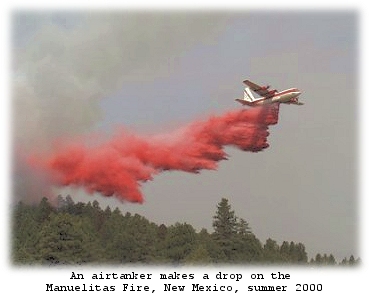 The Forest Service grounded all the federal large airtankers after a series of deadly crashes last fire season, and won't release them until they have been deemed safe by individual inspections. But according to
The Forest Service grounded all the federal large airtankers after a series of deadly crashes last fire season, and won't release them until they have been deemed safe by individual inspections. But according to 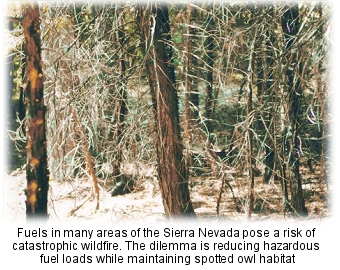 Blackwell says increased timber revenues will help foresters with fuels reductions; he says he's got "compelling evidence" that the original framework plans won't accomplish that goal. But environmentalists say he hasn't given the Sierra plan a chance to work.
Blackwell says increased timber revenues will help foresters with fuels reductions; he says he's got "compelling evidence" that the original framework plans won't accomplish that goal. But environmentalists say he hasn't given the Sierra plan a chance to work.
 The
The 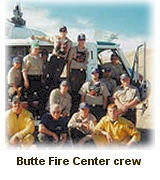 Steele has led an effort to build a 17-mile firebreak around the Magalia area, and he says the Butte Fire Center crews are vital to completing the firebreak. Paradise Fire Chief Jim Broshears said
Steele has led an effort to build a 17-mile firebreak around the Magalia area, and he says the Butte Fire Center crews are vital to completing the firebreak. Paradise Fire Chief Jim Broshears said  "The pictures have given us tangible evidence of what we have been saying for years," she said. "The tone is set by management, and there are sexual harassment issues all over California." Donnelly said the Los Padres has one of the biggest problems, and that the hotshots are not professional. "They have brought shame on the entire Forest Service," she said.
"The pictures have given us tangible evidence of what we have been saying for years," she said. "The tone is set by management, and there are sexual harassment issues all over California." Donnelly said the Los Padres has one of the biggest problems, and that the hotshots are not professional. "They have brought shame on the entire Forest Service," she said.

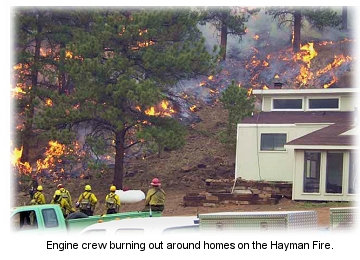 The fact that homes are surrounded by flammable forest doesn't figure in, according to a report by the
The fact that homes are surrounded by flammable forest doesn't figure in, according to a report by the 